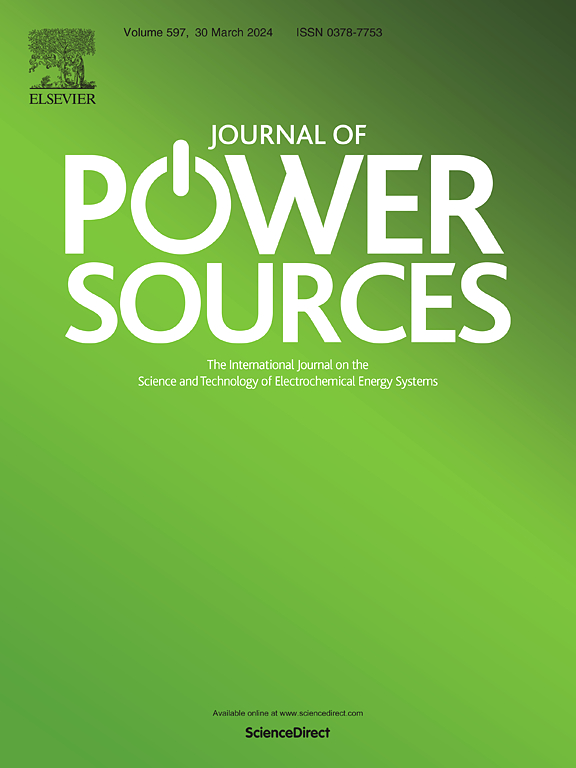Mo, Ni, S doped cobalt carbonate hydroxide ultrathin nanosheet arrays on nickel foam for high-performance hybrid supercapacitors
IF 8.1
2区 工程技术
Q1 CHEMISTRY, PHYSICAL
引用次数: 0
Abstract
Elemental doping and morphological modulation become important strategies for designing electrode materials of high performance supercapacitor. In this paper, Mo and Ni doped cobalt carbonate hydroxide (CCH) nanoneedle arrays (Ni(OH)2@Mo, Ni-CCH) on Ni foam (NF) are first obtained by hydrothermal synthesis. After S doping, Ni(OH)2 nanosheet arrays are cross-linked among Mo, Ni, S doped CCH nanoneedle arrays (Ni(OH)2@Mo, Ni, S-CCH) on NF at room temperature. The Ni(OH)2@Mo, Ni, S-CCH/NF demonstrates a remarkable high specific capacity of 1765 C g−1 at 1 A g−1 and cycle life of 82.1 % after 10, 000 cycles, which is attributed to the synergistic effects of high conductive Ni and Mo doped CCH and microstructural modulation after S doping. Upon assembly with activated carbon (AC), the hybrid supercapacitor (HSC) demonstrates an impressive high energy density of 60.15 Wh kg−1 (at 615.51 W kg−1), maintaining a capacity retention ratio of 91.82 % even after 10, 000 cycles. This demonstrates the great potential of Ni(OH)2@Mo, Ni, S-CCH/NF as an advanced HSC electrode.
泡沫镍上的钼、镍、硒掺杂碳酸钴氢氧化物超薄纳米片阵列用于高性能混合超级电容器
元素掺杂和形态调控已成为设计高性能超级电容器电极材料的重要策略。本文首先通过水热合成法在泡沫镍(NF)上获得了掺杂钼和镍的碳酸钴(CCH)纳米针状阵列(Ni(OH)2@Mo,Ni-CCH)。掺杂 S 后,NF 上的镍(OH)2 纳米片阵列与掺杂 Mo、Ni 和 S 的 CCH 纳米针阵列(镍(OH)2@Mo、Ni、S-CCH)在室温下交联。Ni(OH)2@Mo、Ni、S-CCH/NF 在 1 A g-1 的条件下具有显著的高比容量(1765 C g-1),循环寿命在 10,000 次后达到 82.1%,这归功于掺杂高导电性镍和钼的 CCH 以及掺杂 S 后的微结构调制的协同效应。在与活性炭(AC)组装后,混合超级电容器(HSC)显示出令人印象深刻的高能量密度,达到 60.15 Wh kg-1(615.51 W kg-1),即使在 10,000 次循环后仍能保持 91.82 % 的容量保持率。这证明了 Ni(OH)2@Mo、Ni、S-CCH/NF 作为先进的 HSC 电极的巨大潜力。
本文章由计算机程序翻译,如有差异,请以英文原文为准。
求助全文
约1分钟内获得全文
求助全文
来源期刊

Journal of Power Sources
工程技术-电化学
CiteScore
16.40
自引率
6.50%
发文量
1249
审稿时长
36 days
期刊介绍:
The Journal of Power Sources is a publication catering to researchers and technologists interested in various aspects of the science, technology, and applications of electrochemical power sources. It covers original research and reviews on primary and secondary batteries, fuel cells, supercapacitors, and photo-electrochemical cells.
Topics considered include the research, development and applications of nanomaterials and novel componentry for these devices. Examples of applications of these electrochemical power sources include:
• Portable electronics
• Electric and Hybrid Electric Vehicles
• Uninterruptible Power Supply (UPS) systems
• Storage of renewable energy
• Satellites and deep space probes
• Boats and ships, drones and aircrafts
• Wearable energy storage systems
 求助内容:
求助内容: 应助结果提醒方式:
应助结果提醒方式:


